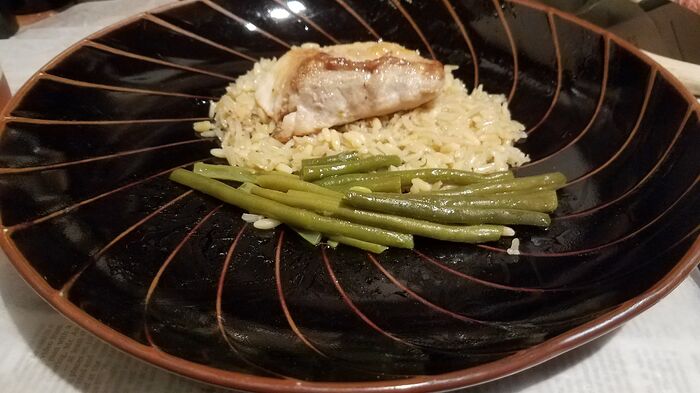slow going! hope you get it all back.
Red Lentil Curry - red lentils are cooked with diced red kuri squash, shallots, garlic, fresno chili, ginger and curry powder. Quarter of it gets pureed before finished with lime zest, honey and cilantro. Served with lime-yoghurt.
Sauteed halibut over pilaf with haricots. My stomach is still uneasy since the election, so I ate only half of it.
Graduated from quesadillas to Kheema, now we’re really talking comfort food.
I had sauteed and frozen a pack of ground turkey ages ago. Made the masala base and finished it last night. Added potato to make it Kheema Aloo and ate it with rice for a warm and happy hug via my mouth. (That’s a pool of spiced ghee in case you’re curious.)
.
Take 2 tonight was Kheema Macaroni – wow, have I missed this! It always tastes better when the pasta is past al dente, because it sops up the spices as it softens.
While there is no wrong way to eat kheema macaroni, there is definitely a best way, and that is with chapatis (at least according to me and the cousin who first committed this atrocity in childhood that I picked up the habit from ![]() ).
).
.
In my little world growing up, my mom invented 3 leftover kheema dishes that are became standalone stars that kheema is now specially made for – kheema macaroni, kheema shepherds pie, and kheema sandwich toast. Yum, yum, and yum.
I’ll have to choose between shepherd’s pie and sandwich toast from what’s left of the kheema, which is not a lot (bec I made extra kheema macaroni for later).
Tonight we had 15-bean and ham soup that I started yesterday with a side of jalapeño cornbread (Jiffy doctored with sour cream and melted butter). Hit the spot and didn’t even need the hot sauce.
Interesting–the Greek word for that ground meat in tomato is “kimi”.
Same linguistic root
Of course. I wonder how it derived, though. Greek is a separate branch of Indo-European from the Indian languages, so the common root was either a long time ago, or the word was more recently borrowed from one of the languages into the other.
Ah. A borrowing, present in many languages from Greece to Persia to India. OED’s etymology:
Etymon: Urdu qīma.
< Urdu qīma minced meat (frequently in compounds denoting specific dishes) < Persian qīma (now more frequently qayma), in the same sense < a Turkic language of Central Asia (compare e.g. Old Uyghur qıyma (adjective, of meat) cut in shreds, Uyghur qiyma (noun) minced meat), ultimately < an unattested verbal base with the sense ‘to cut obliquely in thin stripes, to cut in shreds’.
Notes
Compare also Arabic qīma minced meat < a Turkic language, probably via Persian.
Compare the following early example of the Persian word in an English context (outside India):
- 1856
[In Mecca] we dipped hands in ‘Biryani,’ a meat pillaw…; ‘Kimah,’ finely chopped meat.
Borrowed words abound thanks to conquest – is kyma originally Greek or Turkish?
Kheema is qeema in Urdu, which borrows heavily from Persian and other languages of Muslim conquest into the subcontinent (Mughals and prior.)
So likely where it went into Greek from also.
The OED puts the origin in Urdu, but I think that’s unclear since the word is everywhere in that region.
I had a hankering for XLB in Chinatown, but that had to be nixed due to my still limited mobility ![]()
Instead, we ordered house special fried rice from a joint nearby, and I made a stir-fry with the leftover meat I picked off of last night’s Peruvian chicken plus baby Shanghai we grabbed at the Asian market today. That we had to drive to. ![]()
![]() Because I couldn’t walk 3 blocks
Because I couldn’t walk 3 blocks ![]()
![]()
![]()
I was going to add shrimp & the last king oyster mushroom from the crisper, too, but decided it was going to be too much food. The house special rice included assorted meats plus shrimp anyway.
I used lotsa garlic, a big-ass onion (I can never have too much smoky, sweet, charred onion in my stir-fry), a few Thai bird peppers from the freezer, a lil oyster sauce, few spoons of chili crisp, soy sauce, mirin, oyster sauce, and white pepper. It all came together well — and we didn’t even “have to” leave the house.
Yay.
Usually “everywhere” traces somehow back to old Persian & subsequent trees, lol.
Re your earlier point re Proto Indo European, no, not that far back! I have often rabbit-holed that way, though, so much fun. Took a class long ago that turned PIE into simple, almost math-like conversions as you traveled down different branches, which was pretty amazing.
Kima /Kheema is used all along the Spice Route. Probably spread by the Spice Route.
India also uses halvah as a term for some sweets. They’re different than the Greek sesame halvah and semolina halvah, but they’re still called halvah/ halwa.
Well, this tree says the main branches of PIE split apart 3500-1000 BCE.
You’re right that it’s a lot of fun. This guy has a number of graphics illustrating the derivations of IE words in a number of language.
The word still originated somewhere before traveling. Imma give it to the Turks.
I’m going to give it to the Persians because I’m Greek. ![]() /s
/s
See, whereas I don’t have an issue with factual history of conquests despite my emotions regarding them ![]()
(post deleted by author)













